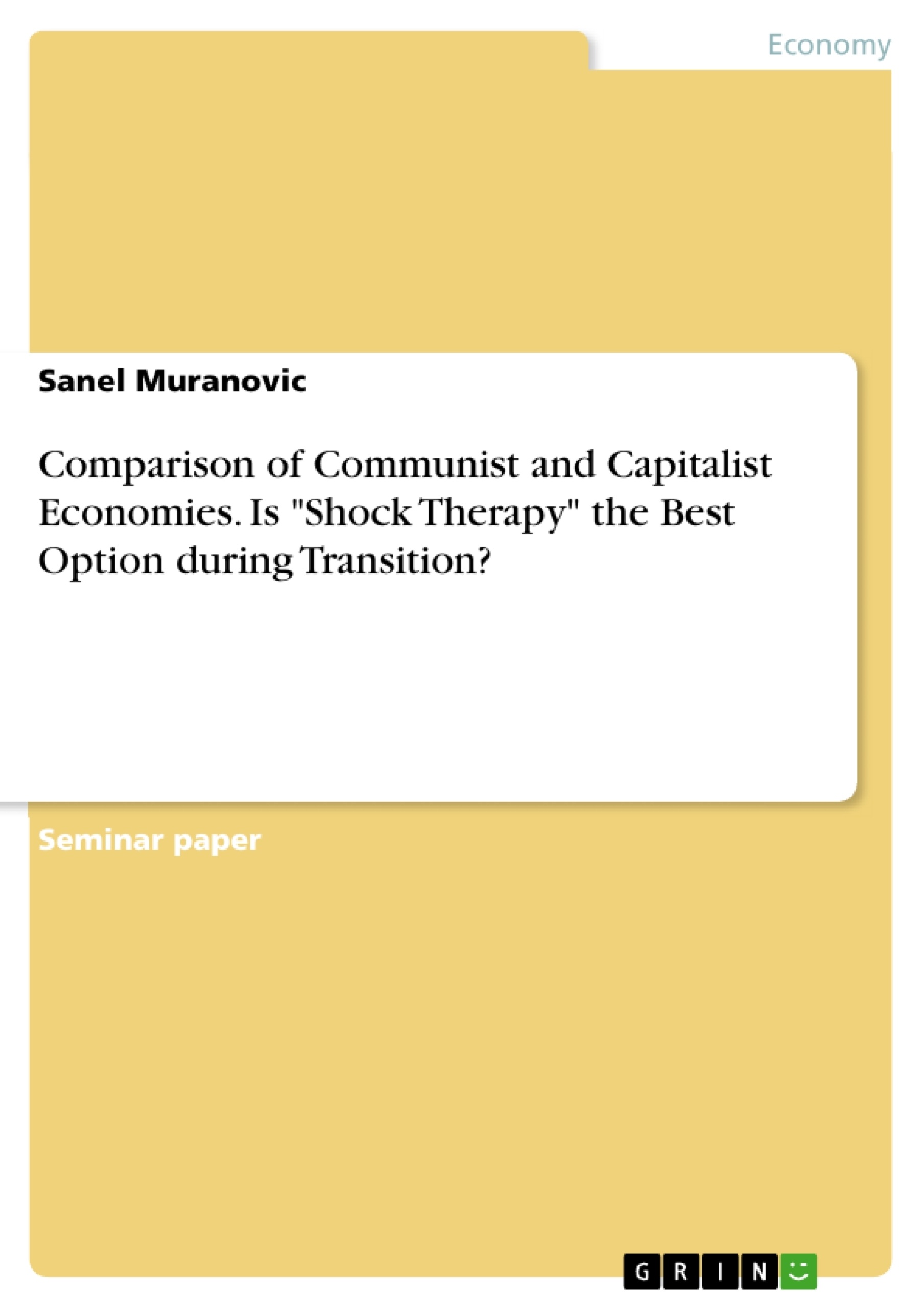This paper compares and contrasts communist party and economic planning in a socialist system with the prices and the market in a capitalist economy. It discusses the successes, failures, effectiveness and flaws of each system in terms of economic and social aspects. Is shock therapy the right approach for a stable long term transition?
Table of Contents
- 1. Task I: Comparison of Communism and Capitalism Economies
- 1.1 Capitalism by the laissez-faire approach
- 1.2 Communism by the economic planning approach
- 1.3 Comparison of the successes, failures and the effectiveness of both systems
- 2. Task II: Is "Shock Therapy" the Best Option during Transition
- 2.1 Shock Therapy: From theory into practice
- 2.2 Assumption to the "success" of shock therapy
Objectives and Key Themes
This paper aims to compare and contrast communist and capitalist economic systems, analyzing their successes, failures, and effectiveness. It further examines the efficacy of "shock therapy" as a transition strategy.
- Comparison of Capitalism and Communism
- Laissez-faire approach in Capitalism
- Economic planning approach in Communism
- Effectiveness of "Shock Therapy"
- Social and economic implications of different economic systems
Chapter Summaries
1. Task I: Comparison of Communism and Capitalism Economies: This chapter provides a detailed comparison of capitalist and communist economic systems. It examines capitalism through the lens of the laissez-faire approach, emphasizing the role of free markets and minimal government intervention, contrasting this with the centrally planned economy of communism. The chapter analyzes the successes and failures of each system, considering both economic and social aspects. It highlights the theoretical underpinnings of each system, referencing Adam Smith's "invisible hand" in the context of capitalism and Marx and Engels' Communist Manifesto for communism. The chapter concludes by acknowledging that pure forms of either system are rare in the modern world, with most economies exhibiting a blend of characteristics.
2. Task II: Is "Shock Therapy" the Best Option during Transition: This chapter delves into the concept of "shock therapy" as a method for transitioning economies from one system to another, particularly from centrally planned to market-based systems. It examines the theoretical underpinnings of shock therapy and its application in real-world scenarios, analyzing its successes and failures. The chapter likely explores the assumptions underlying the belief in shock therapy's effectiveness and critically evaluates whether it constitutes the optimal approach to economic transition. The discussion probably includes an analysis of the potential risks and benefits associated with rapid versus gradual reform strategies, drawing upon real-world examples to support its argument.
Keywords
Capitalism, Communism, Laissez-faire, Economic Planning, Shock Therapy, Economic Transition, Free Market, Centrally Planned Economy, Socialism, Economic Systems, Adam Smith, Karl Marx, Friedrich Engels, Economic Growth, Social Welfare, Inequality.
Frequently Asked Questions: A Comprehensive Language Preview
What is the main focus of this language preview?
This preview provides a structured overview of a document comparing and contrasting communist and capitalist economic systems. It analyzes the effectiveness of both systems, explores the "shock therapy" approach to economic transition, and examines the successes and failures of each method. The preview includes the table of contents, objectives and key themes, chapter summaries, and keywords.
What economic systems are compared?
The document primarily compares and contrasts communism and capitalism. It examines capitalism through the lens of the laissez-faire approach (minimal government intervention) and communism through its centrally planned economic model.
What is the "shock therapy" approach?
The preview examines "shock therapy" as a method for transitioning economies, particularly from centrally planned systems to market-based systems. It analyzes its theoretical basis, real-world applications, successes, and failures, considering the assumptions behind its effectiveness and the potential risks and benefits of rapid versus gradual reforms.
What are the key themes explored?
Key themes include the comparison of capitalism and communism, the laissez-faire approach in capitalism, economic planning in communism, the effectiveness of shock therapy, and the broader social and economic implications of different economic systems.
What are the chapter summaries?
Chapter 1 compares capitalist and communist systems, detailing their successes and failures, theoretical underpinnings, and the rarity of pure forms in the modern world. Chapter 2 explores shock therapy, its theoretical foundations, real-world applications, and a critical evaluation of its efficacy as a transition strategy, weighing the advantages and disadvantages of rapid versus gradual reform.
What are the key words associated with this document?
Keywords include Capitalism, Communism, Laissez-faire, Economic Planning, Shock Therapy, Economic Transition, Free Market, Centrally Planned Economy, Socialism, Economic Systems, Adam Smith, Karl Marx, Friedrich Engels, Economic Growth, Social Welfare, and Inequality.
What is the purpose of this document?
The document aims to provide a comparative analysis of communist and capitalist economic systems and to critically evaluate the effectiveness of "shock therapy" as a means of economic transition.
What are the theoretical perspectives considered?
The document considers the theoretical perspectives of Adam Smith (capitalism's "invisible hand") and Marx and Engels (Communist Manifesto) in its analysis of the two economic systems.
What types of economies are discussed?
The preview discusses both pure forms of capitalist and communist economies as well as the complexities of mixed economies and the challenges of economic transition.
- Quote paper
- Sanel Muranovic (Author), 2016, Comparison of Communist and Capitalist Economies. Is "Shock Therapy" the Best Option during Transition?, Munich, GRIN Verlag, https://www.grin.com/document/341459



